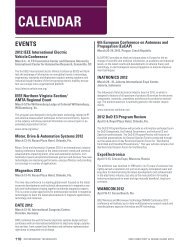2011 EMC Directory & Design Guide - Interference Technology
2011 EMC Directory & Design Guide - Interference Technology
2011 EMC Directory & Design Guide - Interference Technology
Create successful ePaper yourself
Turn your PDF publications into a flip-book with our unique Google optimized e-Paper software.
design<br />
EMI Sources and Their Most Significant Effects<br />
Electromagnetic <strong>Interference</strong> Sources and<br />
Their Most Significant Effects<br />
The increasing number of EMI sources is creating greater<br />
challenges for those responsible for maintaining the interoperability<br />
of products and systems<br />
Anthony A. DiBiase<br />
Spec-Hardened Systems<br />
Rochester, New York USA<br />
As the density of the electromagnetic<br />
environment (EME) continues to<br />
increase the concern for its effects<br />
from sources producing EMI also increases.<br />
Advances in technology and the number of<br />
products produced, is having a significant<br />
effect on the efforts aimed at maintaining<br />
the required operation and inter operability<br />
of products and systems used in our society.<br />
These events have added challenges for<br />
those who are responsible for keeping pace<br />
with the effort required in maintaining the<br />
required level of electromagnetic compatibility<br />
(<strong>EMC</strong>) in these products and systems.<br />
SOURCES<br />
EMI sources both natural and man made<br />
that compose the EME can be categorized<br />
into several primary categories. Some of<br />
these classifications of sources are listed<br />
below.<br />
(1) Ambient EME that is composed of<br />
numerous sources of which the most significant<br />
are:<br />
• Television transmissions both analog and<br />
digital<br />
• Radio AM, FM, and Satellite<br />
• Solar Magnetic Storms which peak on a<br />
eleven year cycle<br />
• Lightning which occurs as a very high<br />
voltage and high current event<br />
• Utility power grid transmission lines<br />
which have high voltage, low current,<br />
and low frequency characteristics. In this<br />
category is also the new technology of<br />
Broadband over Power Lines (BPL) digital<br />
signals.<br />
• Other ambient EME sources include airport<br />
port radar, telecom transmissions,<br />
electrostatic discharge (ESD), and white<br />
noise. Also in this category is the earth’s<br />
magnetic field flux which has a value of<br />
about 500 milligauss.<br />
• Some other major product and system’s<br />
emissions sources include switching<br />
mode power supplies, arc welders, motor<br />
bushes, and electrical contacts<br />
(2) High Powered Electromagnetic Pulse<br />
(HEMP) threats which are intended to disable<br />
electrical and electronic equipment.<br />
These sources are designed to be utilized<br />
by terrorist and military organizations.<br />
Currently existing HEMP devices include<br />
the following:<br />
• Intentional Electromagnetic <strong>Interference</strong><br />
(IEMI) source – a high powered pulse<br />
device utilized by combat, sabotage and<br />
terrorist organizations<br />
• High Altitude Nuclear Electromagnetic<br />
Pulse (HNEMP) – produced by the detonation<br />
of a nuclear device high above the<br />
earth’s atmosphere<br />
• High Powered Microwave Weapon (HPM)<br />
– a device utilized by the military as a<br />
combat weapon<br />
• E-Bomb – a HEMP weapon employed by<br />
122 interference technology emc <strong>Directory</strong> & design guide <strong>2011</strong>


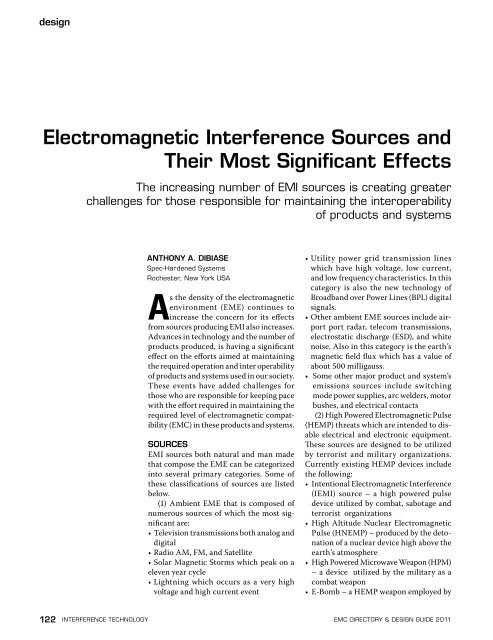

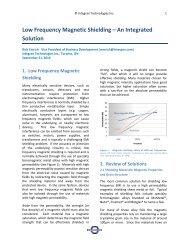

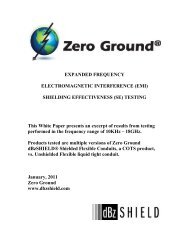
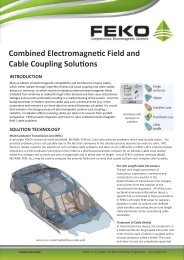



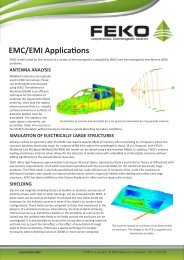
![[ thursday ] morning sessions 8:30 am-noon - Interference Technology](https://img.yumpu.com/23176841/1/190x247/-thursday-morning-sessions-830-am-noon-interference-technology.jpg?quality=85)
